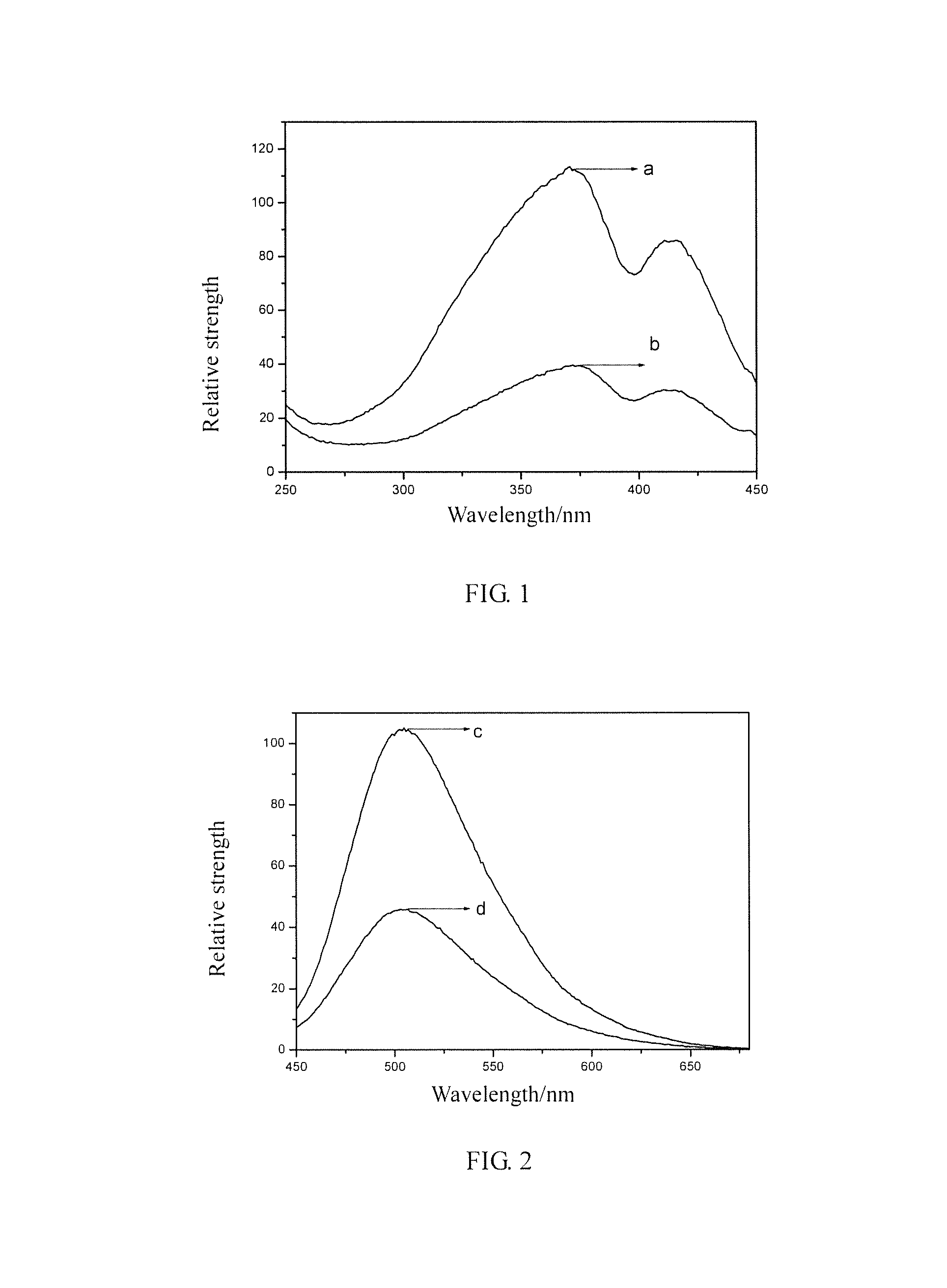Halogen silicate luminescent material and the preparation method and application thereof
a luminescent material and halogen silicate technology, applied in the field of halogen silicate luminescent material and the preparation method and application thereof, can solve the problems of poor color reductibility and low color rendering index of devices, low luminous efficiency, poor stability, etc., and achieve excellent stability, good luminescent property, and high luminous efficiency
- Summary
- Abstract
- Description
- Claims
- Application Information
AI Technical Summary
Benefits of technology
Problems solved by technology
Method used
Image
Examples
example 1
Preparation of (Sr0.7Eu0.3)10Si6O21Cl2:1×10−3Pt by the Sol-gel Method
[0040]Preparation of the Pt nanoparticle sol: Weighing 5.18 mg chloroplatinic acid (H2PtCl6.6H2O) to dissolve into 17 mL deionized water; after chloroplatinic acid is completely dissolved, weighing 8.0 mg sodium citrate and 12.0 mg sodium dodecanesulphonate, and dissolving into the chloroplatinic acid aqueous solution under the magnetic stirring condition; weighing 0.38 mg sodium borohydride to dissolve into 10 mL deionized water to obtain 10 mL sodium borohydride aqueous solution at a concentration of 1×10−3 mol / L, and meanwhile preparing 10 mL hydrazine hydrate solution at a concentration of 1×10−2 mol / L; under the magnetic stirring condition, first dropwise adding 0.4 mL sodium borohydride aqueous solution into the chloroplatinic acid aqueous solution and stirring to react for 5 min, then dropwise adding 2.6 mL 1×10−2 mol / L hydrazine hydrate solution into the chloroplatinic acid aqueous solution, and then contin...
example 2
Preparation of (Ca0.85Eu0.1Mn0.05)10Si6O21Cl2:1×10−2Au by the Sol-gel Method
[0043]Preparation of Au nanoparticle sol: Weighing 4.12 mg chloroauric acid (AuCl3.HCl.4H2O) to dissolve into 8.4 mL deionized water; after chloroauric acid is completely dissolved, weighing 14 mg sodium citrate and 6 mg cetyl trimethylammonium bromide, and dissolving into the chloroauric acid aqueous solution under the magnetic stirring condition; weighing 1.9 mg sodium borohydride and 17.6 mg ascorbic acid to dissolve into 10 mL deionized water, respectively, to obtain 10 mL sodium borohydride aqueous solution at a concentration of 5×10−3 mol / L and 10 mL ascorbic acid aqueous solution at a concentration of 1×10−2 mol / L; under the magnetic stirring condition, first adding 0.04 mL sodium borohydride aqueous solution into the chloroauric acid aqueous solution, stirring to react for 5 min, then adding 1.56 mL 1×10−2 mol / L ascorbic acid aqueous solution into the chloroauric acid aqueous solution, and then conti...
example 3
Preparation of (Ca0.96Eu0.04)10Si6O21Cl2:1×10−4Ag by the Sol-gel Method
[0046]Preparation of the Ag nanoparticle sol: Weighing 3.40 mg silver nitrate (AgNO3) to dissolve into 18.4 mL deionized water; after silver nitrate is completely dissolved, weighing 22 mg sodium citrate and 20 mg PVP, and dissolving into the silver nitrate aqueous solution under the magnetic stirring condition; weighing 5.7 mg sodium borohydride to dissolve into 10 mL deionized water to obtain 10 mL sodium borohydride aqueous solution at a concentration of 1.5×10−2 mol / L; adding 1.6 mL 1.5×10−2 mol / L sodium borohydride aqueous solution into the silver nitrate aqueous solution at one time under the magnetic stirring condition, and then continuing to react for 10 min to obtain 20 mL Ag nanoparticle sol with the Ag concentration at 1×10−3 mol / L; then adding 0.1 g PVP into the Ag nanoparticle sol, and magnetically stirring for 24 h to produce the Ag nanoparticle sol having been subject to the surface treatment.
[0047...
PUM
| Property | Measurement | Unit |
|---|---|---|
| concentration | aaaaa | aaaaa |
| excitation wavelength | aaaaa | aaaaa |
| internal quantum efficiency | aaaaa | aaaaa |
Abstract
Description
Claims
Application Information
 Login to View More
Login to View More - R&D
- Intellectual Property
- Life Sciences
- Materials
- Tech Scout
- Unparalleled Data Quality
- Higher Quality Content
- 60% Fewer Hallucinations
Browse by: Latest US Patents, China's latest patents, Technical Efficacy Thesaurus, Application Domain, Technology Topic, Popular Technical Reports.
© 2025 PatSnap. All rights reserved.Legal|Privacy policy|Modern Slavery Act Transparency Statement|Sitemap|About US| Contact US: help@patsnap.com

